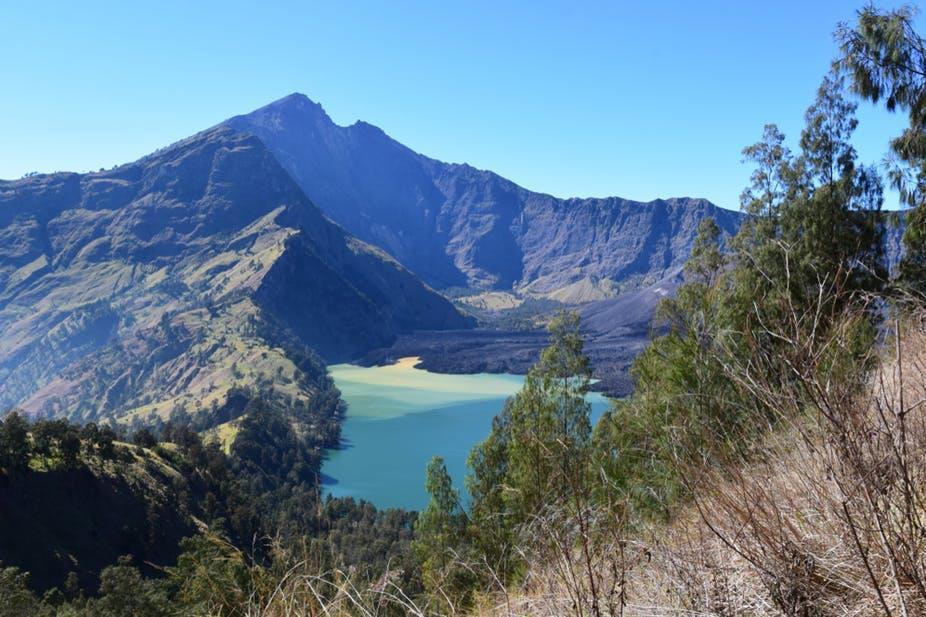
Can the earthquake in Lombok trigger volcanic activities?
The National Disaster Management Agency reportedly counted as of Monday evening at least 98 people dead and hundreds wounded by collapsed building material. Between the July 29 earthquake and the most recent one, there were nearly 500 small aftershocks.
The disaster in Lombok is reminiscent of the great Tohoku earthquake in Japan in 2011. At that time a 9.0 magnitude earthquake struck the east coast of Japan. A few days earlier there were a number of smaller earthquakes. After the mainshock , there were small earthquakes of decreasing strength, which finally stopped when the Earth had stabilised.
Indonesia's Meteorology, Climatology and Geophysics Agency (BMKG) stated that the August 5 earthquake in Lombok was the mainshock . Learning from the experience of the Tohoku earthquake, it is hoped after the main earthquake in Lombok there will be no more major earthquakes.
There are several active volcanoes near the epicentre of the Lombok earthquake – Mount Rinjani in Lombok, Mount Agung in Bali and Mount Tambora in West Nusa Tenggara. How will the large earthquakes and aftershocks affect these volcanoes?
Read more: Explainer: why volcanoes erupt
What is a tectonic earthquake?Tectonic earthquakes are a type of earthquake caused by the shifting of Earth's plates. They usually occur at the boundary between the moving plates that interact.
Indonesia is at the meeting of three main plates: the Eurasian Plate in the north, the Indo-Australian Plate, which goes under the Eurasian Plate, and the Pacific Plate in the east. The movement of these plates causes a gradual buildup of energy. When the accumulation of energy is released suddenly, that's a tectonic earthquake. That's why Indonesia is prone to earthquakes.
To answer how tectonic earthquakes can affect volcanoes, we can learn from tectonic earthquakes in the past in Indonesia and other countries.
The case of Mount Agung Mount Agung emits volcanic ash, seen from Amed Village, Karangasem, Bali, Indonesia, July 03 2018. EPA / Made NagiOn Tuesday, July 3 2018, at 9:32 WITA, Mount Agung, Bali, ejected volcanic ash . A few minutes earlier a 4.9-magnitude tectonic earthquake occurred, 110 kilometres south of Denpasar at a depth of 24km.
Tectonic earthquakes can affect critical volcanoes, which are those on alert status due to an increase in volcanic earthquakes, drying springs, increased gas release and small eruptions.
Volcanoes in critical condition can easily eject dissolved gas or a very large volume of magma if there is a trigger such as an earthquake.
Read more: How Mount Agung's eruption can create the world's most fertile soil
The case of Mount FujiWe can also see one example from Japan. Here, tectonic earthquakes have been recorded causing a volcano to erupt.
On October 28 1707, an 8.6 magnitude earthquake struck the coast along Nakai Megathrust, southwest of Japan. This is one of the biggest earthquakes in Japanese history, claiming more than 5,000 lives. Only the Tohoku earthquake in 2011 had a greater magnitude.
Research by Christine Chesley and colleagues in 2012 found that a tectonic earthquake on October 20 1707 caused magma 20km below Mount Fuji to move up to a shallow magma chamber at a depth of about 8km.
Unfortunately, the chamber was not big enough to accommodate the new magma. This caused Mount Fuji to erupt with a Volcanic Explosivity Index of 5.
Read more: Two types of tectonic plate activity create earthquake and tsunami risk on Lombok
The Mount Fuji eruption was characterised by the release of material that consisted of volcanic ash only without any lava material. This means there had been a sudden change of pressure in the magma chamber.
Reflecting on the case of Mount Fuji, the eruption of Mount Agung in Bali on July 3 2018 after the tectonic earthquake presented the same phenomenon. It ejected volcanic ash without being followed by lava flow.
Both Mount Fuji in 1707 and Mount Agung in 2018 were in critical condition before the tectonic earthquake happened. The Mount Fuji eruption in 1707 and Agung in 2018 are examples of how a tectonic earthquake can trigger a critical volcano.
What about Rinjani and Tambora? Climbers descend from Mount Rinjani on July 30 2018 a day after the earthquake in Lombok. EPA/STRTectonic earthquakes do not always cause volcanoes to erupt. For a tectonic earthquake to trigger a volcanic eruption, the volcano must be in a critical condition.
If a volcano is normal or stable, an ordinary tectonic earthquake would not be strong enough to cause it to erupt.
Tectonic earthquakes will shake and trigger magma to come to the surface when conditions have exceeded the stability limit.
Rinjani and Tambora, which are geographically closer than Agung to the centre of the tectonic earthquake that occurred on Lombok Island, are unlikely to budge, because both are stable. Hopefully.
This article was originally published in Indonesian
- Earthquakes Volcanoes Indonesia Lombok

Legal Disclaimer:
MENAFN provides the
information “as is” without warranty of any kind. We do not accept
any responsibility or liability for the accuracy, content, images,
videos, licenses, completeness, legality, or reliability of the information
contained in this article. If you have any complaints or copyright
issues related to this article, kindly contact the provider above.

















Comments
No comment